09/05/18
K-State Current - September 5, 2018
K-State Current is a weekly news update for the Kansas Board of Regents to apprise the Regents on a few of the many successes and achievements made by K-State faculty, staff and students.

K-State News
Riding with Myers
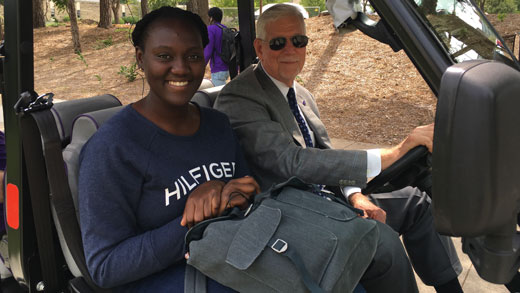 President Richard Myers has a new purple golf cart that was donated by K-State alumnus Eric Stonestreet. On Aug. 30, Myers drove students to class on his way to teach at the Leadership Studies Building.
President Richard Myers has a new purple golf cart that was donated by K-State alumnus Eric Stonestreet. On Aug. 30, Myers drove students to class on his way to teach at the Leadership Studies Building.
Over the course of the semester, Myers will periodically use the golf cart to give students rides on their way to class, weather permitting.
He will use this opportunity to learn more about students' K-State experience and ask questions on how to make K-State a better university for all.
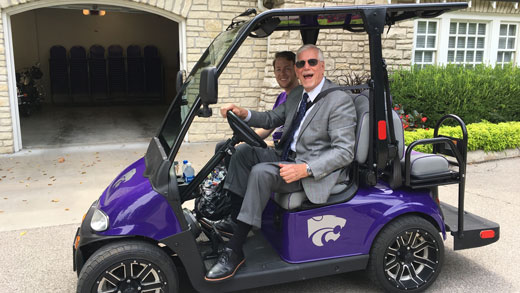
Kansas State University and Topcon sign research agreement, start projects
Kansas State University and Topcon Agriculture are collaborating to develop tools and systems to advance precision agriculture and support farmers.
By working with the university, Topcon Agriculture aims to develop product concepts through gathering requirements, drafting specifications and conducting market research, as well as to test products in the lab, on the university farm and around the state using K-State Research and Extension and Agricultural Experiment Station facilities. 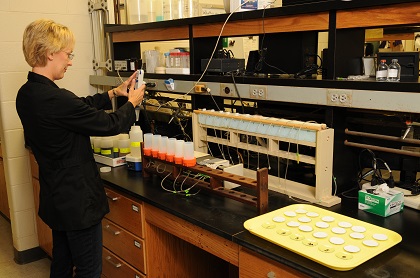
"The strategic advantage of using our combined resources for product development and testing is paramount as Topcon Agriculture is squarely focused on creating value for farmers, dealers and original equipment manufacturers. We encourage farmers to 'Grow without Limits,'" said Brian Sorbe, vice president of sales and marketing for Topcon Agriculture.
"Topcon is globally taking an increasing tactical interest in university partnerships, similar to this great step with K-State. We believe that the intersection between sensors, data and action are within our grasp, and progressive universities like K-State are in a unique position to help us achieve this," said Fabio Isaia, CEO of Topcon Agriculture. "For example, we see K-State as one of the most important partners of TAP, our ag platform, and we look forward to developing together value-added services for our customers."
"Our facilities and research strengths are an excellent fit for Topcon's business," said Ernie Minton, interim dean of the College of Agriculture and director of K-State Research and Extension.
Minton said researchers are interested in working with the company because of its broad, interdisciplinary approach and involvement in many areas that are highly relevant to Kansas producers.
"Partnership with Topcon Agriculture demonstrates our commitment to keeping Kansas producers up to date," Minton said. "Precision agriculture offers new tools that will help farmers prosper as they work to feed the world's growing population."
Kansas State University emphasizes industry collaboration and has seen an 80 percent increase in the number of industry-funded projects in the last five years. The university has successfully pursued master research and service agreements with a number of industry partners.
"Partnership with Topcon Agriculture aligns with our strategy to engage in collaborative research with industry," said Peter Dorhout, the university's vice president for research. "We are committed to strategic, enduring alliances to ensure that some of our applied research results in technology transfer and real-world applications boost the Kansas economy."
"The research collaborations established with Topcon are the beginning of a mutually beneficial partnership, and we look forward to expanding the relationship to advance innovation in precision agriculture in Kansas and beyond," said Rebecca Robinson, director of economic development at the Kansas State University Institute for Commercialization.
Kansas State University and Schlumberger sign three-year agreement valued at $54 million
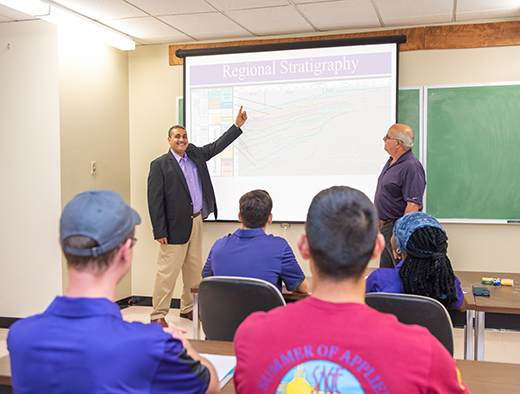 Imagine viewing the Earth 300 million years in the past. Today, that observation would put you 2 miles under the surface of the planet.
Imagine viewing the Earth 300 million years in the past. Today, that observation would put you 2 miles under the surface of the planet.
Thanks to an agreement with Schlumberger — a worldwide provider of technology for reservoir characterization, drilling, production, and processing to the oil and gas industry — Kansas State University researchers in the geology department now have access to a suite of powerful tools to help them delve deeply into the past, when petroleum reserves were formed. The three-year agreement is valued at $18 million per year and provides the university access to the Petrel* E&P software and Techlog* wellbore software platforms; PetroMod* petroleum systems modeling software; and GeoX exploration risk, resource and value assessment software.
Matt Totten and Abdelmoneam Raef, associate professors of geology, said these tools will help the university address petroleum production problems in Kansas.
"Kansas has produced petroleum for a long time," Totten said. "We're still No. 8 in the country. But there have never been adequate models to describe the system — the environment in which the rocks, or reservoirs, were formed, how they were buried and the rate at which they were buried, and all of this influences production." Totten said.
According to Raef, more sophisticated information gathering and data integration are particularly important in Kansas, where many petroleum operators are small and don't have access to the technology
"We can offer cost savings and solutions to industry partners," Raef said. "We are working to develop our research in adopting advanced machine learning to better integrate oil and gas data."
Pamela Kempton, head of the geology department in the College of Arts and Sciences, said the partnership will not only benefit research and teaching at Kansas State University but also produce valuable information for Schlumberger.
"Our graduate students will benefit from the experience of using advanced tools, which will help them in the job market," Kempton said. "Our researchers also will provide feedback on the performance of the tools and offer ideas for improvements."
"This agreement highlights the outstanding work of the faculty and geology department," said Amit Chakrabarti, dean of the College of Arts and Sciences. "This group has achieved much, and with further investment in modernized facilities, it is poised to achieve a leadership position in teaching and research excellence."
Peter Dorhout, Kansas State University vice president for research, said the Schlumberger agreement demonstrates the high quality of the petroleum research program and the university's industry-friendly processes.
"Working with industry is key to the economic success of Kansas, and our team has realized an 80 percent increase in the number of industry-funded projects in the last six years," Dorhout said. "We're proud to add Schlumberger to our growing list of industry technology partners."
Totten and Raef said looking to the Earth's past brings a bright future for the Kansas oil and gas industry. Based on the Schlumberger agreement, they have already spoken to five companies that are interested in working with the geology department by providing data or supporting graduate students. They also foresee more efficient drilling with a smaller environmental footprint.
"With these tools, we can improve production significantly with less of a surface footprint," Raef said. "We can drill at one site instead of 10 or 15 drilling sites."
K-State Faculty Highlight
Engineering professors funded by NSF to study clean water from wastewater initiative
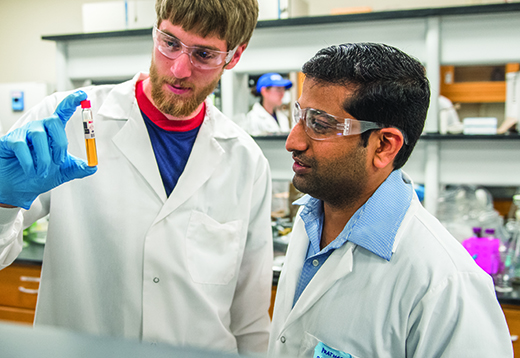 Two Kansas State University College of Engineering professors will use a three-year, $304,427 grant from the National Science Foundation Environmental Engineering Program for a project improving a wastewater cleaning process.
Two Kansas State University College of Engineering professors will use a three-year, $304,427 grant from the National Science Foundation Environmental Engineering Program for a project improving a wastewater cleaning process.
Anaerobic membrane bioreactors are an emerging green technology for generating clean water for reuse from municipal and agro-industrial wastewaters while also producing methane gas to achieve an energy-neutral operation.
However, the bioreactors are limited by several factors, most prominent of which is the formation of biofilms on membranes within the reactor. This limits treatment capacity, adds to operation costs and ultimately makes a full-scale anaerobic membrane bioreactor operation unfeasible.
The NSF-funded study by Ryan Hansen, assistant professor of chemical engineering and lead investigator, and Prathap Parameswaran, assistant professor of civil engineering, seeks to gain a better understanding of how these biofilms form over the membrane surfaces.
The researchers will work to develop a novel analytical method of removing individual microorganisms from the membrane surface in order to sequence and identify microbes that initiate the fouling process. They will also characterize physical and chemical properties of the membrane material that make it prone to fouling.
"Membrane biofouling is a limiting factor in many water and wastewater treatment systems, and despite many years of research, is still a big problem," Hansen said. "We plan to provide new understanding of the fouling process by identifying specific subsets of microorganisms in waste streams known as 'early colonizers' — those that initiate biofilm formation by attaching to the membrane early on."
"If these organisms are identified, we may be able to target them and slow the fouling process," Parameswaran said. "By developing cutting-edge methods for studying the early colonizers, we also hope to apply this fundamental knowledge to areas beyond water/wastewater treatment systems."
The research team will have the unique opportunity to apply these tools to a pilot-scale anaerobic membrane bioreactor system during this project.
"This project will improve our understanding of how biofilms form on membrane surfaces in water treatment systems and give us information on treatment options that alienate membrane biofouling," Hansen said. "In the long term, our goal is to aid the development of an economically feasible anaerobic membrane bioreactor operation."
Two other objectives of the study will be the involvement of students who will be better prepared for successful careers in sustainable energy and environmental engineering, as well as providing research opportunities for underrepresented students throughout Kansas.
Veterinary researchers represent K-State at international swine disease symposium in China
This summer, an international meeting in China featured a visible group of researchers from the K-State College of Veterinary Medicine.
The 2018 International Porcine Reproductive and Respiratory Syndrome Symposium was hosted June 11-13 at the Yuelai International Convention Center, in Chongqing, China. Raymond "Bob" Rowland, from the diagnostic medicine and pathobiology department, joined Hanchun Yang from the China Agricultural University, Beijing, as the symposium organizers, along with the help from Ying Fang, also from the diagnostic medicine and pathobiology department. 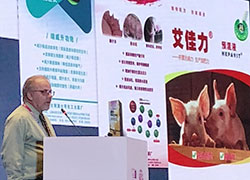
The four-day meeting featured talks from international experts on porcine reproductive and respiratory syndrome virus, or PRRSV, which has global impact on pork production. The conference hosted about 2,000 attendees from all over the world. The symposium was in conjunction with the International Pig Veterinary Society conference. Rowland and Yang gave the welcome address.
The College of Veterinary Medicine was well-represented with seven attendees. Rowland and Fang chaired scientific sessions and delivered keynote presentations. Fang delivered the opening keynote on "Novel mechanisms of PRRSV infection: intercellular transmission and persistence," while Rowland presented a keynote talk on "Models for understanding the genetics of the host response to PRRSV."
Student travel fellowships were awarded, including three to diagnostic medicine and pathobiology graduate students: Ana Stoian, Xingyu Yan and Fangfeng Yuan.
College of Veterinary Medicine students, postdocs and faculty gave a variety of presentations at the conference that are listed below.
Oral Presentations:
- Ana Stoian, "Peptide sequence domains in SRCR5 of CD163 that contribute to recognition by PRRSV-2."
- Jianfa Bai, Kansas State Veterinary Diagnostic Laboratory, "Genome diversity and multiplex detection assay development for PCV3 and PCV2 viruses" and "Development of a Luminex multiplex assay for the detection of PRRS and PCV viruses and for PRRS vaccine differentiations in the U.S."
Posters:
- Xingyu Yan, "Genetic characterization of emerging variants of PRRSV in the United States: new features of -2/-1 programmed ribosome."
- Fangfeng Yuan, "Porcine reproductive and respiratory syndrome virus nsp1alpha associated with mitochondrion dysfunction" and "A quantitative real-time RT-PCR assay for rapid detection of genetically diversified atypical porcine pestivirus strains in North America."
K-State Student News
Engineering students take first place in HVAC design competition
A team from the architectural engineering and construction science department at Kansas State University has taken first place in the 2018 ASHRAE Student Design Competition and Setty Family Foundation Applied Engineering Challenge in the HVAC System Selection category.
The competitions recognize outstanding student design projects and encourage students to become involved in the design of energy-efficient HVAC systems. A total of 63 teams participated with 35 judged at the society level.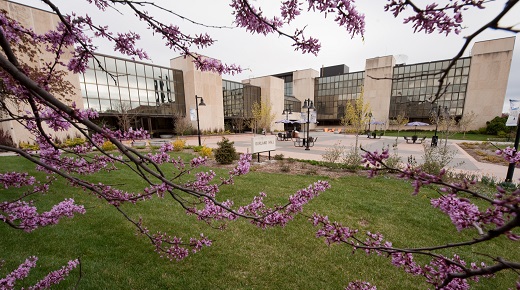
The Kansas State University team submitted its competition presentation and report digitally in May to the judging committee at the local level, which for the university is the Kansas City ASHRAE chapter. From there the entry went on to the region level, ASHRAE Region IX, for judging. First-place entries from each of the 15 regions were then sent to the international level of the society for judging in June at ASHRAE’s annual conference in Houston.
This year’s competition project focused on a new 70,000-square-foot, four-story, mixed-use complex north of Istanbul, Turkey, near the new international airport. The facility featured retail and office spaces, a restaurant and a hotel in support of the upcoming rapid growth in the area when the airport is completed in 2019.
The students selected water-to-air heat pumps, water-to-water heat pumps, active chilled beams and a hybrid ground loop/cooling tower. The system proposal allows for integration of sustainable solutions encompassing energy efficiency, human comfort and productivity, indoor environmental quality and architectural aesthetics.
Team members, all spring 2018 graduates in architectural engineering, were as follows: Whitney Luck, El Dorado; Andres Saldivar, Garden City; Madison Hopfinger, Overland Park; Kevin Clark, Solomon; and Evan Reese, St. Marys.
Faculty advisers were Julia Keen, professor, and Fred Hasler, associate professor, both from the department of architectural engineering and construction science.
The projects will be shared and awards presented at the 2019 ASHRAE Winter Conference, Jan. 12-16, in Atlanta.
ASHRAE, founded in 1894, is a global society advancing human well-being through sustainable technology for the built environment. The society and its more than 56,000 members worldwide focus on building systems, energy efficiency, indoor air quality, refrigeration and sustainability.